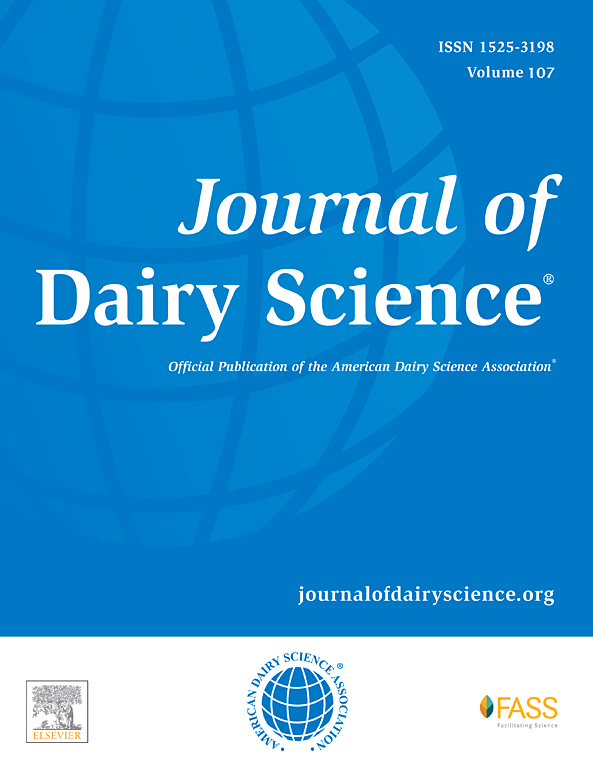Single-step genomic predictions for crossbred Holstein and Jersey cattle using metafounders
IF 4.4
1区 农林科学
Q1 AGRICULTURE, DAIRY & ANIMAL SCIENCE
引用次数: 0
Abstract
The study examined the impact of incorporating metafounders (MF) in single-step GBLUP (ssGBLUP) models for the genetic evaluation of Holstein (HO) and Jersey (JE) cattle with their crossbreds (CROSS). The dataset included 23,736,975 records on 8,560,986 cows. Genotypic data on 181,379 JE, 1,905,292 HO, and 53,799 CROSS animals were used for the evaluation. The genetic evaluation included 5 production traits, namely, milk yield (MY), protein yield (PY), fat yield (FY), SCS, and daughter pregnancy rate (DPR), which were analyzed using a 5-trait repeatability model using ssGBLUP with or without MF. Three different MF scenarios were tested: 4 MF (based on breed), 24 MF (based on the combination of breed, sex, and year of birth), and 32 MF (similar to 24 MF but with CROSS as a separate genetic group). The 3 MF scenarios were compared with a conventional ssGBLUP model that did not include metafounders (NO_MF). Forward-in-time validation was carried out to evaluate predictability, inflation, and stability. For purebred Holstein and Jersey cows, the truncated dataset included phenotypes through December 2018, whereas for crossbreds, the cutoff was December 2015; the complete dataset extended through December 2022. Validation targeted genotyped cows lacking records in their respective truncated dataset but with at least one record in the complete dataset, yielding 96,295 Holsteins, 26,436 Jerseys, and 5,099 crossbreds for analysis. Results showed that including MF affected prediction metrics differently depending on the trait, breed, and MF configuration. While certain MF classifications (e.g., 4 MF) reduce bias and improve predictability in crossbreds for some traits, others show minimal effects, particularly in purebred Holsteins. For low h2 traits (SCS, DPR), MF scenarios provided better predictive ability in CROSS animals. In contrast, for high h2 traits (MY, PY, FY), stability tended to decrease in MF models, suggesting possible overfitting due to added model complexity. Overall, MF offers a promising strategy to address pedigree gaps in multibreed evaluations, but its application should be carefully tailored to trait architecture and population composition to avoid overfitting and ensure accurate genetic predictions.
利用元创建者对杂交的荷斯坦牛和泽西牛进行单步基因组预测。
本研究考察了在单步基因组BLUP (ssGBLUP)模型中加入元创建者(MF)对荷斯坦牛(HO)和泽西牛(JE)及其杂交品种(CROSS)遗传评价的影响。该数据集包括8,560,986头奶牛的23,736,975条记录。使用181,379只乙脑、1,905,292只HO和53,799只CROSS动物的基因型数据进行评估。遗传评价包括产奶量(MY)、蛋白质产量(PY)、脂肪产量(FY)、SCS和子代妊娠率(DPR) 5个生产性状,采用ssGBLUP建立的5性状重复性模型对有无MF进行分析。测试了三种不同的MF情景:4 MF(基于品种)、24 MF(基于品种、性别和出生年份的组合)和32 MF(与24 MF相似,但CROSS作为单独的遗传组)。将这3种MF情景与不包括元创始人(NO_MF)的传统ssGBLUP模型进行比较。进行及时前向验证以评估可预测性、通膨性和稳定性。对于纯种荷斯坦奶牛和泽西奶牛,截断的数据集包括截至2018年12月的表型,而对于杂交奶牛,截止日期为2015年12月;完整的数据集延伸至2022年12月。验证的目标是在各自的截断数据集中缺乏记录,但在完整数据集中至少有一条记录的基因型奶牛,产生96,295头荷斯坦奶牛,26,436头泽西奶牛和5,099头杂交奶牛用于分析。结果表明,包括MF对预测指标的影响取决于性状、品种和MF配置。虽然某些MF分类(例如4 MF)减少了偏倚,提高了杂交品种某些性状的可预测性,但其他分类的影响很小,特别是在纯种霍尔斯坦犬中。对于低h2性状(SCS, DPR), MF情景在CROSS动物中提供了更好的预测能力。相反,对于高h2性状(MY, PY, FY), MF模型的稳定性趋于下降,表明可能由于模型复杂性的增加而过度拟合。总体而言,MF为解决多品种评估中的谱系差距提供了一种很有前景的策略,但其应用应谨慎地根据性状结构和种群组成进行调整,以避免过度拟合并确保准确的遗传预测。
本文章由计算机程序翻译,如有差异,请以英文原文为准。
求助全文
约1分钟内获得全文
求助全文
来源期刊

Journal of Dairy Science
农林科学-奶制品与动物科学
CiteScore
7.90
自引率
17.10%
发文量
784
审稿时长
4.2 months
期刊介绍:
The official journal of the American Dairy Science Association®, Journal of Dairy Science® (JDS) is the leading peer-reviewed general dairy research journal in the world. JDS readers represent education, industry, and government agencies in more than 70 countries with interests in biochemistry, breeding, economics, engineering, environment, food science, genetics, microbiology, nutrition, pathology, physiology, processing, public health, quality assurance, and sanitation.
 求助内容:
求助内容: 应助结果提醒方式:
应助结果提醒方式:


